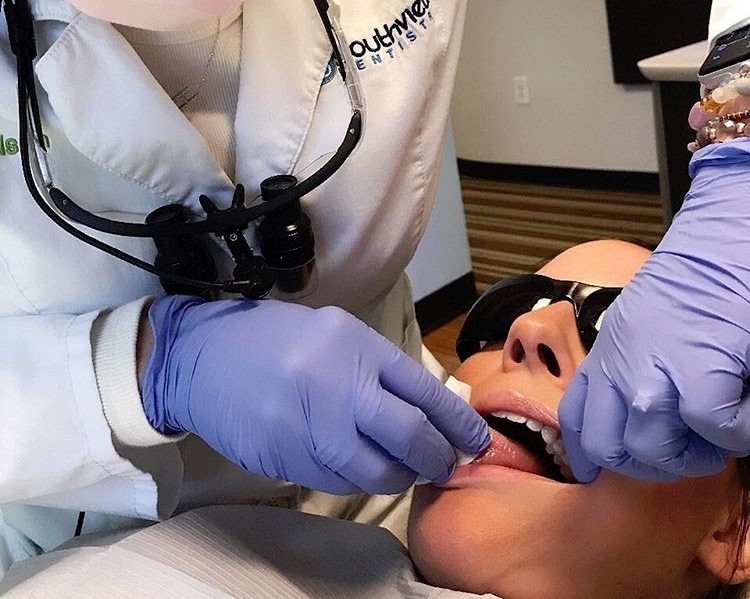
Bad Food for Teeth: Seemingly Healthy Foods to Avoid
March 7, 2019
Oral Cancer Awareness Month: The Importance of Cancer Screenings and Head and Neck Exams
April 10, 2019Did you just have your Wisdom Teeth removed? One of the most common issues after wisdom tooth removal is dry socket. Learn about dry socket prevention for a healthy mouth for smooth and more comfortable recovery from your extraction.
For most people, recovery from a wisdom tooth just requires rest and a little pain relief. Unfortunately, a minority of patients experience dry socket after the removal of one or more wisdom teeth. Columbia University estimates that around 5% of all patients experience dry socket after a tooth extraction.
Usually a blood clot forms in each tooth socket after an extraction, but sometimes the clot gets dislodged or just doesn’t form. Since the bone and nerves are exposed, this creates a “dry socket” which is often painful. Fortunately, if you pay attention to the symptoms you may get treatment early before the condition worsens.
Keep in mind that this post is intended for general education purposes and not intended as medical advice. if you experience the symptoms described later, call your dentist for advice, and examination, or treatment.
Causes Of Dry Socket
There are a number of possible causes for dry socket including:
- Suction from sucking drinks through straws
- Smoking and vaping
- Bits of food getting stuck in the exposed tooth socket
- Poor oral hygiene
- Coughing or sneezing due to allergies, illness or a cold
- Spitting
- Sometimes the cause is unclear, so be aware of the symptoms
The first 4-5 days after a wisdom tooth extraction is the most important for dry socket prevention. While the risk of developing dry socket is low, be sure to pay attention to how you feel and any new symptoms while you heal. Knowing the symptoms you know when to call your dentist for treatment.
Be Aware Of Some Of The Common Symptoms Of Dry Socket
- You may experience pain originating a couple of days after the removal of your wisdom teeth. The pain may be dull or throbbing. It may feel localized or it may radiate throughout the face or to the ears.
- You may see what looks like a dry opening at the extraction site. Normally you would see a blood clot there after an extraction.
- You or your loved ones may notice bad breath.
- You may also experience an unpleasant taste.
If you experience the symptoms of dry socket, be sure to call your dentist. To prepare, make notes of the specific oral symptoms you experience. Also, bring a list of any prescription medications and supplements you take, including antibiotics or pain medication. Your dentist may also suggest home care and suggest that you limit certain foods while healing from the dry socket.
Sometimes, your dentist may need to do other tests to make sure the dry socket isn’t caused by a more serious condition. Healing time varies, but with correct treatment, most people feel better within one to two weeks.
In rare cases, dry socket may slow your healing or even result in additional infection and discomfort. Some symptoms of infection include fever, chills, more intense pain, puss, and swelling. This is why it is so important to contact your dentist if you experience any symptoms of dry socket.
Now that you know the symptoms, follow these guidelines to promote healing and prevent dry socket. Also, be sure to follow any additional home care instructions from your dentist or your dental surgeon.
Dry Socket Prevention Tips For The First Week After An Extraction
- Practice oral hygiene as instructed by your dentist.
- If you were prescribed a dental rinse use it as directed.
- Eat soft foods, and avoid sharp or hard foods. Examples of soft foods include applesauce, smoothies, or yogurt. Avoid sucking or slurping hot soups. If you drink a smoothie, avoid using a straw.
- Rinse your mouth with salt water after eating to discourage the growth of bacteria.
- Avoid sodas and carbonated beverages.
- Don’t touch the wound while it heals other than when following your home care and hygiene instructions.
- If you smoke, quit smoking for at least a few days while you heal. Consider using a patch to wean yourself off cigarettes.
- Drink plenty of water or other clear fluids to maintain healthy hydration levels.
- Avoid using straws as you heal since the suction can dislodge the blood vessel.
- Avoid vigorous spitting.
- Rest and avoid strenuous exercise or work until your dentist says it is okay. Most dentists suggest waiting 3-4 days after an extraction to workout.
- Be aware that hormonal birth control like oral contraceptives increases the risk of developing dry socket. Consider going off them before your extraction, or at least informing your dentist that you use them.
- Be careful to avoid further trauma or injury to your jaw as you heal.
You may have noticed a pattern among the guidelines for dry socket prevention. Basically, be gentle with your mouth for the weeks that you are healing.
What To Eat While You Heal From Dry Socket
As mentioned, soft foods are best for dry socket prevention. Some examples include yogurt, cottage cheese, smoothie bowls, smooth cereal, mashed potatoes, and other soft foods. Avoid sucking or slurping soups or drinks through straws since this may possibly dislodge the blood vessel.
Also avoid eating sharp, hard, crunchy or sticky foods that may get lodged into your socket or may a further irritation. Sugary drinks are not ideal, but water and other clear unsweetened fluids aid healing.
Your dentist may suggest that you gently rinse your mouth with salt water or a special rinse after eating to prevent bacterial buildup. Be careful not to spit but instead open your mouth and let the fluids fall out naturally.
Most patients heal quickly from the removal of wisdom teeth. However healing times may vary depending on other factors like existing infection, health issues, age, and genetics. Be cautious and get plenty of rest.
Southview Dentistry is one of the most trusted dentists in the Charlotte area. If you live in the area and need a dentist or are experiencing any dental discomfort, call today to schedule an examination.




